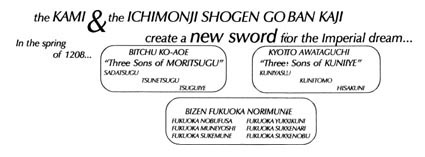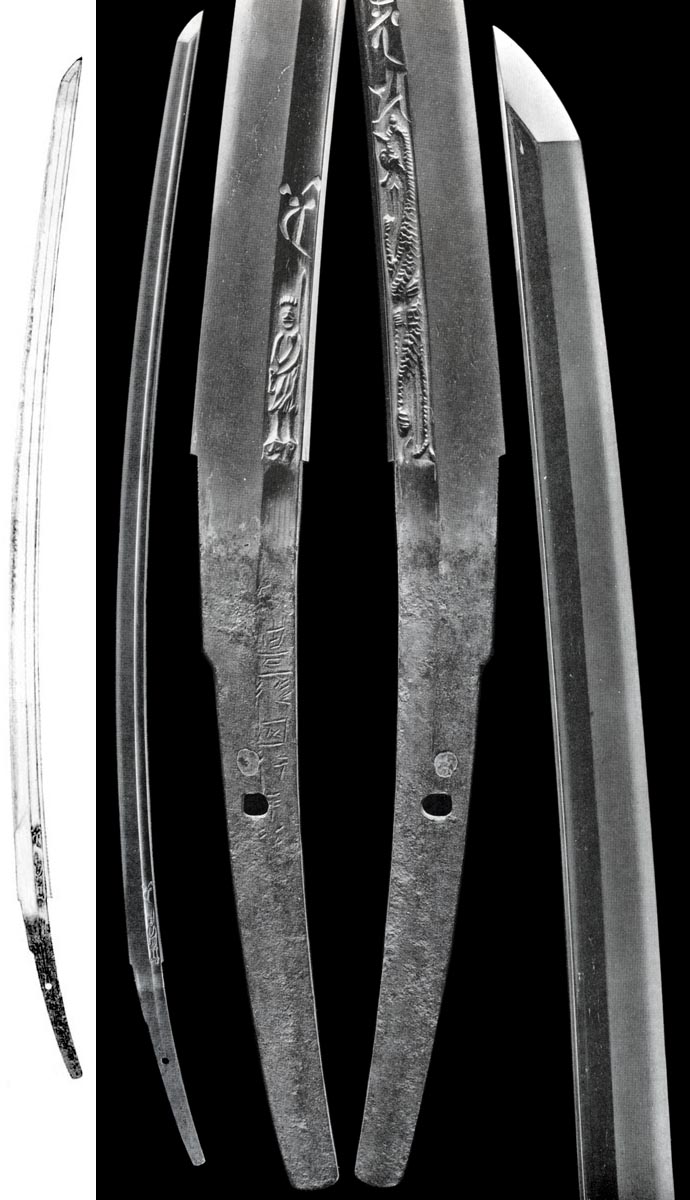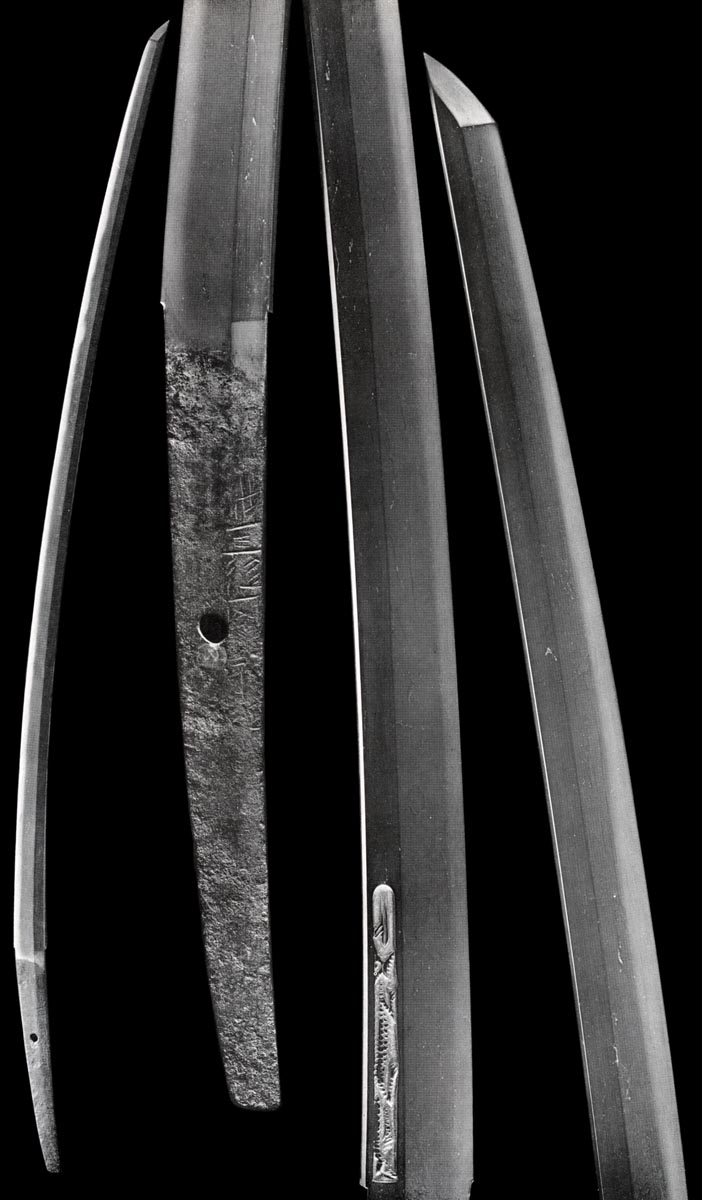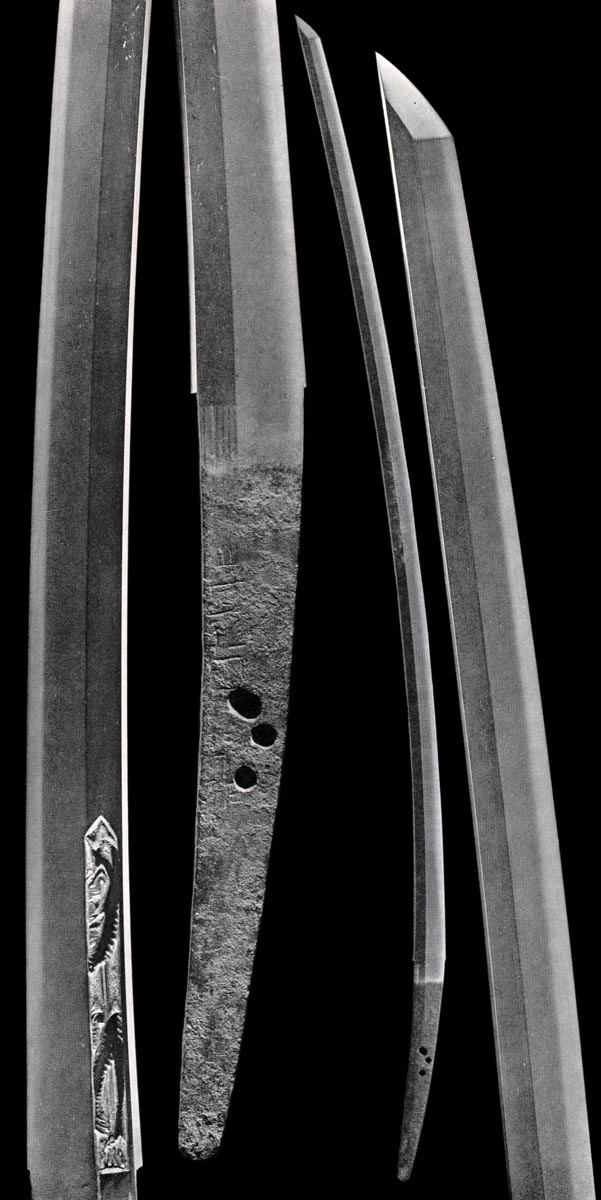| © Copyright Robert Cole 2015
- No copying or distributing - The Eight DO SAIKAIDO - The Eight Roads of KOTO |
|
| BUNGO
HIKOZAN School - YUKIHIRA
HIKOZAN SANZENBO "The Three
Thousand Priests" of HIKOZAN - were not all sword
smiths. The SHUGEN-DO YAMABUSHI covered the
mountain with Temples heralding
MASAYA-AKATSU-KACHI-HAYAHI-AMA-NO-OSHIHOMIMI no
MIKOTO, |
Deeply curved FUNBARI TACHI. Moist and _________ running ITAME. SUGU KO-MIDARE with YO MORISHIGE DAI-DO 806 in NIE. KINSUJI and INAZUMA. HOTSURE. _________________ YAMATO SO SADANRI KAN-JI 1087 ______ YUKIHIRA EI-EN 987 TEISHU - HIKOZAN Priest YO-WA 1181 MASATSUNE CHO-GEN 1028 |______________________ USA TOMOYUKI TEN-NIN 1108 ____|___ ____|___ ________ YUKIHIRA GEN-KYU 1204 SHIGEIYE GEN-RYAKU KIYOHIRA GEN-RYAKU |______________________ ________________ ___________________ ____|____ ___|____ __________|____ | MASATSUNE SHO-KYU 1219 KANEHIRA MUTSU YUKISHIGE KEN-KYU 1190 | ____|____ SHO-JI ____________|____ | YOSHIKUNI TEI-O 1222 SENJUIN SHIGEYUKI TEM-PUKU 1233 | |_____________ YUKIHIRA-ZABURO "Third YUKIHIRA" | ____|___ ____|____ | MUNEYASU SADAYOSHI KEN-PO 1213 | KAN-GEN 1243 YOSHINORI/SADANORI/SADANARI(t&f: YUKIHIRA) | ___|____ | SADANORI KEN-CHO 1249 | ___|____ ________ | SADAHARU BUN-EI 1264 SADASUYE YO-WA 1181 | _________ _________ ____________________ ________________| ___|____ ___|____ ___|____ ________ ___|____ SADAHARU YUKIZANE YASUNORI YASUSADA IYESHIGE SHO-JI 1199 - SHO-KYU 1219 - | -SHO-JI 1199- ___|____ _________________| SHIGEIYE KAN-GEN 1243 _____|__ -brothers- ___|_____ YASUNARI YASUMITSU GEN-KYU 1204 KAN-EI 1206 ___|_____ MITSUTOMO TEN-PUKU 1233 _________ KUNITSUNA NIN-PYO 1151 ____|____ SUKECHIKA SHO-JI 1199 ____|__ ARIYUKITEI-O 1222 _____________ __________ KI MITSUTSUNE TEM-PUKU 1233 KI ARIHIRA KO-CHO 1261 _______|____ __________ KI KUNITSUNA BUN-RYAKU 1234 MITSUTSUNE KO-AN 1278 |___________becomes_________ ____|____ _______|___ KUNITSUGU KUNITSUNA KA-REKI 1326 KI TOMOSADA KEN-CHO 1249 | SHO-O 1288 _______|____ ___|_____ KI MASATSUNE SHO-CHU 1324 TOMOTSUGU SHO-WA 1312 |
TEISHU YO-WA: Forever held in priestly reverence, he was never called SADAHIDE, the alternate pronunciation. Long reported the father of YUKIHIRA, his name was SEIKEN when he was head student among the HIKOZAN-SANZENBO Three Thousand Priests of HIKOZAN. These true YAMABUSHI priests of HIKOZAN dedicated their work to the son of AMATERASU "The Divine Goddess of the Sun." As signatures are known to vary and the work style, in his steel, differs somewhat from that of YUKIHIRA, questions have arisen as to their true relationship. Both, however, are leaders in BUNGO and exhibit YAMASHIRO sword style. Deeply curved HEIAN KOSHIZORI, KO-KISSAKI TACHI with deep FUNBARI. SORI in MONOUCHI may straighten. He also made curveless TANTO. His moist steel is a drawn and running KO-ITAME with thick, wet JI-NIE; and the CHIKEI reveals the KITAE, an old forging pattern. HOTSURE strays from the HABUCHI which will be made up of particularly wet and deep-falling NIOI. KINSUJI and excellent KO-NIE FUKASHI that seems to gather together strikes a beautiful balance in his swimming and brilliant YAKIBA. The range of which is thinning SUGU KO-MIDARE of small inlets with KO-ASHI to KO-MIDARE of CHOJI BA. YAKIOTOSHI is an expected feature. BOSHI: SUGU NIE-KUDZURE with KO-MARU. TEISHU SO TEISHU TEISHU SAKU BUNGOnoKUNI SO TEISHU BUNGOnoKUNI SO TEISHU SAKU |
|
JUYO BIJUTSU HIN TEISHU

|
| ICHIMONJI
NI-JU YO-NIN GOBAN “24-man Goban” KAJI
One of the most pivotal smiths in all of history In YUKIHIRA, we have an enigma. He is called KISHIN-DAYU, 'The Great Man of the New KI. TAYU means Great Man or Big Boss. BUNGO KI is their school. |
| He was a priest of the HIKO YAMA-BUSHI, “Three
Thousand Priests” or Temples of Mt HIKO, Imperialists
all, bred to the bone.
KI appears, along with attributions to YUKIHIRA, in several characters. One, “ONI,” is used for the first GASSAN, ONIOMARU, or KIYOMARU. The same KI is put with SHIN for “God” or KAMI, “KI-SHIN” or Devil-KAMI. YUKIHIRA is called HOSHI or “person in charge of care” as he worked, and had students, in YAMATO, MUTSU and KOZUKE. URIZANE is SHIN-DAYU, who is YUKIHIRA and also his son, YASUNORI. MUTSU SHOBUTSU is URIZANE and another listed as HOJU. We see these names, YUKIHIRA and his students, ardent and active Imperialists, popping up all over the main style artery of Japan, that long tread track of MUTSU to YAMATO to Big City, KYOTO. |
YUKIHIRA GEN-KYU (t: SO TEISHU): 24 GOBAN KAJI - 4th month. Said a priest of HIKOZAN. KISHINDAYU, - the new KI man. BIZEN, HEIAN style, deeply curved and narrowing to a small KO-KISSAKI or wide bladed CHU-KISSAKI. KO-ITAME with O-HADA that seems drawn. A delicate, UTSURI JI-NIE appears like vapor. KO-MIDARE KO-CHOJI BA with ASHI in KO-NIE and deep NIOI. KINSUJI and SUNAGASHI. HOTSURE. YAKIOTOSHI (HAMON drops away near the MACHI) is a trait. BOSHI can be HAKIKAKE from YAKIZUME. Believed the originator of KURIKARA dragon HORIMONO in a frame. It has been reported that red lacquer applied to the carved frame was a common expectation of the day. May sign on either side. Occasionally signed with his "Hidden" MEI: MUNEHIDE YUKIHIRA MUNEHIDE YUKIHIRA SAKU BUNGOnoKUNI YUKIHIRA BUNGOnoKUNI YUKIHIRA SAKU Tokubetsu Juyo Yukihira |
| History has forgotten the singular efforts of this great
supporter of the Imperial House and his coordinating
and securing GOTOBA’s new ICHIMONJI
sword revolution and armaments supply for the
coming Imperial Restoration.
This Heavenly adjustment
would correct the imbalance created for society when
Samurai governance imposed itself over the
offices and precincts of grandfather, GO-SHIRAKAWA. The HOJO were keeping power only by holding the vacant MINAMOTO SHOGUNAL banner, with an obscure 2 year old, following 3rd SHOGUN, MINAMOTO SANETOMO’s assassination. As a 12 year old, GOTOBA
signed away the true right of the Imperial Throne,
its power to govern, to |
 |
| It was
for this, YUKIHIRA, with his Imperialist, YAMABUSHI, HIKOZAN Priests and far flung
students, would work and give their tireless
preparation.
YUKIHIRA’s HIKOZAN Priests were reverers of AMATERASU’s eldest son. BUNGO had been Imperial ever since SHINSOKU brought his HACHIMAN-GU in 712 AD (See BUZEN). YUKIHIRA and students appear in all the diverse provinces that contributed secrets and methodology to KYOTO and GOTOBA’s secret, Imperial manufacturing conspiracy. Swords to restore the Throne. BUNGO, MUTSU to YAMATO SENJUIN, - YUKIHIRA’s was the same path and style mix that led to the YAMASHIRO RAI and, later, SOSHU style waves. - The ancient road. See KAMAKURA Schoolspdf |
 |
| SOSHU would take from this
same style-river. Following the failure of the
Imperial Cause in the SHOKYU-RAN war, which left
FUKUOKA producing its magical ICHIMONJI proto-type,
SOSHU would pass its own style record out from
KAMAKURA to the North and to the South.
The HOJO's SOSHU, MASAMUNE sword style is a history that came as a wave, over the top of the paths of YUKIHIRA and their ICHIMONJI GOBAN of GOTOBA’s Imperial dream. |

|

| HOSOKAWA
FUJITAKA TEN-MON 4, 1535 to KEI-CHO
15, 1610. He championed ASHIKAGA YOSHIAKI over the ASHIKAGA infant brother, YOSHIHIDE, being backed by the MIYOSHI (See DAIHANNYA). It was he that brought NOBUNAGA into the game and which led to the destruction of the MIYOSHI and punishing of the ASAKURA and ASAI (See ODANI & KATSUIYE). He received OTOKUNI in YAMASHIRO and fought with HIDEYOSHI against the MORI. At the same time his son, TADAOKI, received TANGO fighting in conjunction with AKECHI MITSUHIDE's SANINDO SEIBATSU in TAMBA. He married MITSUHIDE's daughter but refused his father-in-law's call against the ODA. Although married, he expressed his position by having her cloistered. She would be Baptized later, "Gracia." Because he sought union between IYEYASU and HIDEYOSHI's favored proponent, MAEDA TOSHIIYE, ISHIDA KAZUSHIGE listed TADAOKI's family to reside as hostages in OSAKA. Rather than be hampered with the lives of his family, TADAOKI sent word that they should die before being taken. Gracia willingly accepted. She was 38. After 1600, he was transferred to BUZEN using the name HOSOKAWA. He was decisive in the siege at OSAKA ruining the TOYOTOMI forever. TADAOKI's father never raised against IYEYASU and never took part in SEKIGAHARA. He died in 1610 before the OSAKA SEIBATSU. |
|
YUKIHIRA TACHI
NAGASA: 88.8cm SORI: 1.8cm A new version of the old
style. ITAME HADA with a luminous veil of JI-NIE. ASAKI-NOTARE present KO-MIDARE BA of KO-ASHI IRI in NIOI and KO-NIE. SUNAGASHI sweeps through figures. NOTARE-KOMI to slight turnback. The YAKIBA falls to YAKI-OTOSHI. There is a deeply carved 'Statue in a Niche' with a BONJI just above in the KOSHI-OMOTE. UBU NAKAGO with three MEKUGI-ANA. Signed
TACHI URA-MEI: |

Deep NIOI-GUCHI marks a YAKIBA that hangs closely on the HA but for the rising argument of complex tempests. The smallest KO-NIE cling in the HABUCHI where HATARAKI of KINSUJI and SUNAGASHI ploy the constant change of varying KO-GUNOME and KO-CHOJI. Large KOSHIBA rise on both sides through the lower and resolve in his expected and famous YAKI-OTOSHI. BOSHI follows the FUKURA around to the SAKI where a slight HAKIKAKE of his fine KO-NIE is discerned. YUKIHIRA's
“hidden” name is signed TACHI URA-MEI:
The
NAKAGO SUGATA is unarguable.
Munehide
(Yukihira) |
Yukihira
- Kokuho Yukihira - Kokuho Nagasa: 79.2cm Moto-Haba: 3cm Shinogi-Tsukuri, Ihori-Mune, Koshizori, Funbari, Ko-Kissaki Tachi. Kurikara in a frame Koshi-Horimono. Standing Itame Hada with Ji-Nie. Asaki-Notare and rolling Notare falls to Hoso-Suguha in the lower. Sunagashi develops through the mid. Hoso-Sugu Hakikake Boshi. Ubu Kurijiri with one Mekugi-ana. Bungo-no-Kuni Yukihira Saku |
Yukihira
- Kokuho Yukihira - Kokuho Nagasa: 77.4cm Moto-Haba: 2.5cm Shinogi-Tsukuri, Ihori-Mune, Koshizori, Funbari, Ko-Kissaki Tachi. Presented as Gift to Shrine in Kansho Ninen Juni Gatsu Kichi Nichi (1461) Kurikara and Ken in a frame at the Koshi. Standing Itame Hada has Ji-Nie. Asaki-Notare Chu-Suguha. Sunagashi and Nijuba in the mid. Yaki-Otoshi at the Moto. Hoso-Sugu Hakikake Boshi. Ubu Kurijiri with three Mekugi-ana. Bungo-no-Kuni Yukihira Saku |
YASUNORI SHO-JI (t: YUKIHIRA): To GEN-NIN 1224. ITAME MASAME, "running HADA" with SUGU, MIDARE and NOTARE-MIDARE HAMON patterns. Also signed URIZANE YASUNORI URIZANE MASATSUNE SHO-KYU (grf: YUKIHIRA): Styled after BIZEN MASATSUNE. ITAME. HOSO-SUGUHA with ASHI, NOTARE-MIDARE and NIE-FUKASHI KO-CHOJI MIDARE with ASHI. SADAYOSHI (f: YOSHIKUNI, grf: MASATSUNE, t: YUKIHIRA): KOZUKE JU. KI smith. GUNOME KO-MIDARE in NIE. Other signatures were YOSHINORI, SADANORI and SADANARI. BUNGO-no-KUNI SADAYOSHI SAKU IYESHIGE SHO-JI (t: YUKIHIRA): Defined MOKUME. SUGU KO-MIDARE and NOTARE BA. |
______________ BUNGO CHOEN CHOEN smiths from BUNGO produced rough MASAME furrowed ITAME. More CHOEN in BUZEN ____________ NA-RYO-HOSHI GEN-RYAKU:KO-MASAME. HOSO-SUGU KO-GUNOME MIDARE. BUNGO CHOEN line heads to fortify the CHIKUZEN coast: KAMAKURA. ______ RYOSAI BUN-RYAKU 1234 |____________________________________________ ___|__________________________ ___|__ KUNIYOSHI (Priest name: SAIREN) KO-AN 1278 NYUSAI EI-NIN 1293 ___|__ JITSUA(2) KA-GEN 1303 (Father of CHIKUZEN SA) See CHIKUZEN |
|